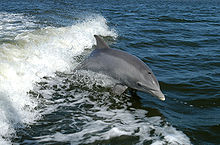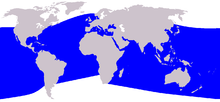- Common bottlenose dolphin
-
This article is about the species of dolphin. For the genus of dolphin, see Bottlenose dolphin.
Common Bottlenose Dolphin[1] 
Bottlenose Dolphin breaching in the bow wave of a boat 
Size compared to an average human Conservation status Scientific classification Kingdom: Animalia Phylum: Chordata Class: Mammalia Order: Cetacea Family: Delphinidae Genus: Tursiops Species: T. truncatus Binomial name Tursiops truncatus
(Montagu, 1821)
Bottlenose Dolphin range (in blue) Tursiops truncatus, commonly known as the Common Bottlenose Dolphin, is the most well-known species from the family Delphinidae.
Common bottlenose dolphins are the most familiar dolphins due to the wide exposure they receive in captivity in marine parks, dolphinarias, in movies, and television programs (for example Flipper).[3] T. truncatus are the largest species of the beaked dolphins.[4] They inhabit temperate and tropical oceans throughout the world, and are absent only from polar waters.[3][4][5][6][7] The bottlenose dolphins previously known as T. truncatus, but recently the genus has been split into two, T. truncatus and T. aduncus.[6][7] Although this species has been traditionally called the Bottlenose Dolphin,[8][9] many authors have used the name Common Bottlenose Dolphin for this species since a second bottlenose dolphins species, the Indo-Pacific Bottlenose Dolphin, was described.[1][10][11] The Common Bottlenose Dolphins inhabit warm and temperate seas worldwide. Considerable genetic variation has been described among members of this species, even between neighboring populations, and so many experts believe that there may be multiple species included within Tursiops truncatus.[8][10]
Contents
Description
The Common Bottlenose Dolphins are grey in color and may be between 2 and 4 metres (6.6 and 13 ft) long, and weigh between 150 and 650 kilograms (330 and 1,400 lb).[9] Males are generally larger and heavier than females. In most parts of the world the adult's length is between 2.5 and 3.5 metres (8.2 and 11 ft) with weight ranges between 200 and 500 kilograms (440 and 1,100 lb).[10][12] Newborn Common Bottlenose Dolphins are between 0.8 and 1.4 meters long and weigh between 15 and 30 kilograms.[10] The common bottlenose dolphins have a short and well-defined snout, that looks like an old-fashioned gin bottle, which is the source for the common name, Bottlenose Dolphin.[13] Like all whales and dolphins, though, the snout is not a functional nose; rather, the functional nose is the blowhole on the top of their head. Their neck is more flexible than other dolphins' due to 5 of their 7 vertebrae not being fused together as is seen in other dolphin species.[14]
Behavior
The Common Bottlenose Dolphins live in groups called pods that typically number about fifteen dolphins, but group size varies from solitary bottlenose dolphins up to groups of over 100 or even occasionally over 1000 animals.[10] Their diet consists mainly of eels, squid, shrimp and wide variety of fishes.[1][5] They do not chew their food, instead swallowing it whole. Dolphin groups often work as a team to harvest schools of fish, but they also hunt individually. Dolphins search for prey primarily using echolocation, which is similar to sonar. They emit clicking sounds and listen for the return echo to determine the location and shape of nearby items, including potential prey.[15] The Common Bottlenose Dolphins also use sound for communication. Sounds used for communication include squeaks and whistles emitted from the blowhole and sounds emitted through body language, such as leaping from the water and slapping their tails on the water. Their head contains an oily substance to protect the brain case and to act as an acoustic lens.
Distribution
T. truncatus can be found in the warm and temperate tropical oceans worldwide.[16] Some populations of the Common Bottlenose Dolphin live closer to the shore (inshore populations) and others live further out to sea (offshore populations). Generally, offshore populations are larger, darker, and have proportionally shorter fins and beaks. Offshore poulations can migrate up to 4,200 kilometres (2,600 mi) in a season, but inshore populations tend to move less. However, some inshore populations make long migrations in response to El Niño-Southern Oscillation events.[10]
Intelligence
Main article: Cetacean intelligenceT. truncatus have a bigger brain than humans.[17] There have been numerous investigations of Common Bottlenose Dolphin intelligence, including tests of mimicry, use of artificial language, object categorization, and self-recognition.[18][19][20][21][22][23] This intelligence has driven considerable interaction with humans. The common bottlenose dolphins are popular in aquarium shows and television programs such as Flipper.[24] They have also been trained for military uses such as locating sea mines or detecting and marking enemy divers, as for example in the U.S. Navy Marine Mammal Program.[25][26] In some areas they cooperate with local fishermen by driving fish toward the fishermen and eating the fish that escape the fishermen's nets.[27]
Other interactions with humans
Some interactions with humans are harmful to the dolphins. In the town of Taiji, Japan some 23,000 are hunted for food annually.[28] Also, the dolphins are sometimes killed inadvertently as a bycatch of tuna fishing.[29][30]
Conservation
The North Sea, Baltic Sea, Mediterranean and Black sea populations of the common bottlenose dolphin are listed on Appendix II[31] of the Convention on the Conservation of Migratory Species of Wild Animals (CMS), since they have an unfavourable conservation status or would benefit significantly from international co-operation organised by tailored agreements.
The species is covered by the Agreement on the Conservation of Small Cetaceans of the Baltic, North East Atlantic, Irish and North Seas (ASCOBANS), the Agreement on the Conservation of Cetaceans in the Black Sea, Mediterranean Sea and Contiguous Atlantic Area (ACCOBAMS), the Memorandum of Understanding for the Conservation of Cetaceans and Their Habitats in the Pacific Islands Region (Pacific Cetaceans MoU)and the Memorandum of Understanding Concerning the Conservation of the Manatee and Small Cetaceans of Western Africa and Macaronesia (Western African Aquatic Mammals MoU).
Further reading
- Heptner, V. G.; Nasimovich, A. A; Bannikov, Andrei Grigorevich; Hoffmann, Robert S, Mammals of the Soviet Union, Volume II, part 3 (1996). Washington, D.C. : Smithsonian Institution Libraries and National Science Foundation
- Ryan, C., Rongan, E. and Cross, T. 2010. The use of Cork Harbour by bottlenose dolphins (Tursiops truncatus (Montagu, 1821)) Ir Nat. J. 31: 1 - 9.
References
- ^ a b c Wells, R. and Scott, M. (2002). "Bottlenose Dolphins". In Perrin, W.; Wursig, B. and Thewissen, J.. Encyclopedia of Marine Mammals. Academic Press. pp. 122–127. ISBN 0-12-551340-2.
- ^ Hammond, P.S., Bearzi, G., Bjørge, A., Forney, K., Karczmarski, L., Kasuya, T., Perrin, W.F., Scott, M.D., Wang, J.Y., Wells, R.S. & Wilson, B. (2008). Tursiops truncatus. In: IUCN 2008. IUCN Red List of Threatened Species. Downloaded on 7 October 2008.
- ^ a b Leatherwood, S., & Reeves, R. (1990). The Bottlenose Dolphin. San Diego: Academic Press, Inc
- ^ a b Ballenger, L., & Lindsley, T. (2003). Tursiops truncatus. Retrieved January 17, 2009, from Animal Diversity Web: http://animaldiversity.ummz.umich.edu/site/accounts/information/Tursiops_truncatus.htm
- ^ a b Anonymous. (2002) Bottlenose Dolphin. Retrieved January 17, 2009, from Sea World Web: http://www.seaworld.org/infobooks/Bottlenose/
- ^ a b Hammond, P., Bearzi, G., Bjørge, A., Forney, K., Karczmarski, L., Kasuya, T., et al. (2008). Tursiops truncatus. Retrieved January 17, 2009, from IUCN Red List of Threatened Species: http://www.iucnredlist.org
- ^ a b Klinowska, M. (1991). Dolphins, Porpoises and Whales of the World: The IUCN Red Data Book. Gland, Switzerland, U.K.: IUCN and Cambridge
- ^ a b Mead, James G.; Brownell, Robert L., Jr. (16 November 2005). "Order Cetacea (pp. 723-743)". In Wilson, Don E., and Reeder, DeeAnn M., eds. Mammal Species of the World: A Taxonomic and Geographic Reference (3rd ed.). Baltimore: Johns Hopkins University Press, 2 vols. (2142 pp.). ISBN 978-0-8018-8221-0. OCLC 62265494. http://www.bucknell.edu/msw3/browse.asp?id=14300099.
- ^ a b American Cetacean Society Fact Sheet - Bottlenose Dolphin
- ^ a b c d e f Shirihai, H. and Jarrett, B. (2006). Whales Dolphins and Other Marine Mammals of the World. Princeton: Princeton Univ. Press. pp. 155–158. ISBN 0-691-12757-3.
- ^ Reeves, R.; Stewart, B.; Clapham, P.; Powell, J. (2002). National Audubon Society Guide to Marine Mammals of the World. New York: A.A. Knopf. pp. 362–365. ISBN 0-375-41141-0.
- ^ http://animaldiversity.ummz.umich.edu/site/accounts/information/Tursiops_truncatus.html
- ^ Tursiops truncatus, Bottlenose Dolphin - MarineBio.org. Retrieved Thursday, February 12, 2009, from http://marinebio.org/species.asp?id=33
- ^ Wells, R.S. (2006). American Cetacean Society Fact Sheet: Bottlenose Dolphin (Tursiops truncatus). Retrieved January 17, 2009, from American Vetacean Society Web: http://www.asconline.org
- ^ Au, Whitlow (1993). The Sonar of Dolphins. New York: Springer-Verlag.
- ^ Scott, M., & Chivers, S. (1990). Distribution and Herd Structure of Bottlenose Dolphins in the Eastern Tropical Pacific Ocean. In S. Leatherwood, & R. Reeves, The Bottlenose Dolphin (pp. 387-402). San Diego: Academic Press, Inc
- ^ url=http://viaclinica.com/article.php?pmc_id=1868071
- ^ Spontaneous vocal mimicry and production by bottlenose dolphins (Tursiops truncatus): evidence for vocal learning. PMID 8375147. is one example
- ^ "The Dolphin Institute - Behavioral Mimicry". http://www.dolphin-institute.org/our_research/dolphin_research/behavioralmimicry.htm. Retrieved 2008-08-31.
- ^ Herman, L. (2002). "Language Learning". In Perrin, W.; Wursig, B. and Thewissen, J.. Encyclopedia of Marine Mammals. Academic Press. pp. 685–689. ISBN 0-12-551340-2.
- ^ "The Dolphin Institute - Understanding Language". http://www.dolphin-institute.org/our_research/dolphin_research/understandinglanguage.htm. Retrieved 2008-09-31.
- ^ "Intelligence and Humans". http://www.wiu.edu/users/emp102/DolphinWeb/dolphin_intel.html. Retrieved 2008-08-11.
- ^ Marten, K. & Psarakos, S. (195). "Evidence of self-awareness in the bottlenose dolphin (Tursiops truncatus)". In Parker, S. T., Mitchell, R. & Boccia, M.. Self-awareness in Animals and Humans: Developmental Perspectives. Cambridge University Press. pp. 361–379. http://earthtrust.org/delbook.html. Retrieved 2008-10-04.
- ^ "American Cetacean Society - Bottlenose Dolphin". http://www.acsonline.org/factpack/btlnose.htm. Retrieved 2008-08-31.
- ^ "U.S. Navy Marine Mammal Program Web Site". U.S. Navy Marine Mammal Program. http://www.spawar.navy.mil/sandiego/technology/mammals/NMMP_FAQ.html. Retrieved 2000-01-18.
- ^ "Dolphins Deployed as Undersea Agents in Iraq". National Geographic. http://news.nationalgeographic.com/news/2003/03/0328_030328_wardolphins_2.html. Retrieved 2009-01-18.
- ^ "Bottlenose Dolphin". Archived from the original on 2008-04-21. http://web.archive.org/web/20080421225641/http://ourworld.compuserve.com/homepages/jaap/tursiops.htm. Retrieved 2008-08-11.
- ^ "Save Japan Dolphins". http://www.savejapandolphins.org/faq.php. Retrieved 2008-09-30.
- ^ Kenyon, P. (2004-11-08). "Dining with the dolphin hunters". BBC News. http://news.bbc.co.uk/2/hi/programmes/this_world/3956355.stm. Retrieved 2008-09-30.
- ^ "The Dolphin Institute - Threats to the Bottlenose Dolphin and Other Marine Mammals". http://www.dolphin-institute.org/resource_guide/conservation.htm. Retrieved 2008-09-30.
- ^ "Appendix II" of the Convention on the Conservation of Migratory Species of Wild Animals (CMS). As amended by the Conference of the Parties in 1985, 1988, 1991, 1994, 1997, 1999, 2002, 2005 and 2008. Effective: 5th March 2009.
External links
- Convention on Migratory Species page on the Common bottlenose dolphin
- Official website of the Agreement on the Conservation of Small Cetaceans of the Baltic, North East Atlantic, Irish and North Seas
- Official website of the Agreement on the Conservation of Cetaceans in the Black Sea, Mediterranean Sea and Contiguous Atlantic Area
- Webpage on the Memorandum of Understanding Concerning the Conservation of the Manatee and Small Cetaceans of Western Africa and Macaronesia at CMS
- Official webpage of the Memorandum of Understanding for the Conservation of Cetaceans and Their Habitats in the Pacific Islands Region
Categories:- IUCN Red List least concern species
- Oceanic dolphins
- Tool-using species
- Megafauna of Australia
- Megafauna of Eurasia
- Megafauna of Africa
- Fauna of the Indian Ocean
- Cetaceans of Australia
- Fauna of the Atlantic Ocean
- Fauna of the Pacific Ocean
- Animals described in 1821
Wikimedia Foundation. 2010.



